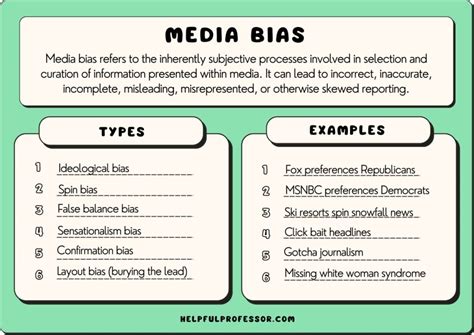Bias is a pervasive issue that affects various aspects of our lives, from personal relationships and social interactions to professional decision-making and scientific research. Understanding the different types of bias and how they manifest is crucial for making informed decisions and promoting fairness and equality. In this article, we will delve into seven examples of bias, exploring their definitions, consequences, and implications for individuals and society.
Key Points
- Confirmation bias: the tendency to seek and interpret information that confirms pre-existing beliefs or hypotheses
- Anchoring bias: the reliance on the first piece of information encountered when making a decision, even if it's irrelevant or inaccurate
- Availability heuristic: the overestimation of the importance or likelihood of information that is readily available, rather than seeking a more diverse range of data
- Hindsight bias: the tendency to believe, after an event has occurred, that it was predictable and that one would have predicted it
- Self-serving bias: the tendency to attribute one's successes to internal factors and one's failures to external factors
- Actor-observer bias: the tendency to attribute one's own behavior to external factors, while attributing others' behavior to internal factors
- Fundamental attribution error: the tendency to overestimate the role of personality and underestimate the impact of situational factors in shaping behavior
Understanding Confirmation Bias

Confirmation bias is a pervasive cognitive bias that affects how we process information. It refers to the tendency to seek, interpret, and remember information that confirms our pre-existing beliefs or hypotheses, while ignoring or dismissing contradictory evidence. This bias can lead to misguided decisions, as individuals may overlook critical information that challenges their assumptions. For instance, a manager may be inclined to believe that a particular marketing strategy is effective because it aligns with their prior experience, even if the data suggests otherwise.
Consequences of Anchoring Bias
Anchoring bias occurs when individuals rely too heavily on the first piece of information they encounter when making a decision. This can lead to suboptimal choices, as the initial information may be inaccurate or incomplete. For example, a consumer may be influenced by the initial price of a product, even if subsequent research reveals that similar products are available at lower prices. To mitigate this bias, it’s essential to consider multiple sources of information and evaluate them critically.
| Type of Bias | Description | Example |
|---|---|---|
| Availability Heuristic | Overestimation of the importance or likelihood of readily available information | A person overestimating the risk of a plane crash due to recent media coverage |
| Hindsight Bias | Believing, after an event has occurred, that it was predictable and that one would have predicted it | A stock investor believing they would have predicted a market downturn, even if they had no prior indication of it |
| Self-Serving Bias | Attributing successes to internal factors and failures to external factors | An employee attributing their success to their skills, while blaming their failure on external circumstances |

Addressing Actor-Observer Bias and Fundamental Attribution Error

Actor-observer bias and fundamental attribution error are two related biases that can lead to misunderstandings and miscommunications. Actor-observer bias refers to the tendency to attribute one’s own behavior to external factors, while attributing others’ behavior to internal factors. Fundamental attribution error, on the other hand, involves overestimating the role of personality and underestimating the impact of situational factors in shaping behavior. To overcome these biases, it’s crucial to consider the complexities of human behavior and the interplay between internal and external factors.
Strategies for Mitigating Bias
To mitigate the effects of bias, individuals can employ several strategies. These include seeking diverse perspectives, evaluating evidence critically, and considering alternative explanations. Additionally, recognizing one’s own biases and being open to feedback can help individuals make more informed decisions and promote a more nuanced understanding of complex issues.
What is the difference between confirmation bias and anchoring bias?
+Confirmation bias refers to the tendency to seek and interpret information that confirms pre-existing beliefs or hypotheses, while anchoring bias involves relying too heavily on the first piece of information encountered when making a decision.
How can I overcome my own biases and make more informed decisions?
+To overcome your own biases, it's essential to recognize their existence, seek diverse perspectives, and evaluate evidence critically. Being open to feedback and considering alternative explanations can also help you make more informed decisions.
What are the consequences of neglecting to address biases in decision-making?
+Neglecting to address biases in decision-making can lead to suboptimal choices, miscommunications, and misunderstandings. It can also perpetuate existing inequalities and reinforce harmful stereotypes, ultimately affecting individuals and society as a whole.
In conclusion, understanding and addressing biases is crucial for making informed decisions and promoting fairness and equality. By recognizing the different types of bias and their consequences, individuals can take steps to mitigate their effects and foster a more nuanced understanding of complex issues. Ultimately, acknowledging and addressing biases can lead to more informed decision-making, improved relationships, and a more just and equitable society.


